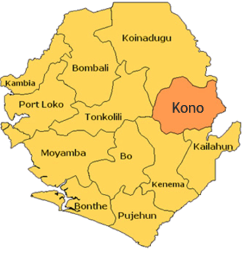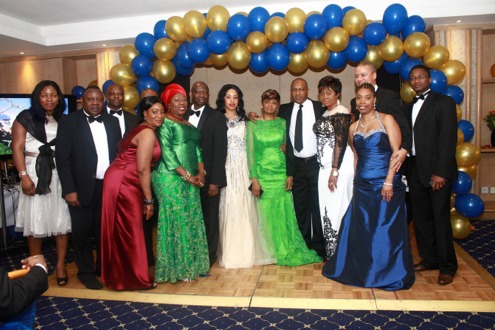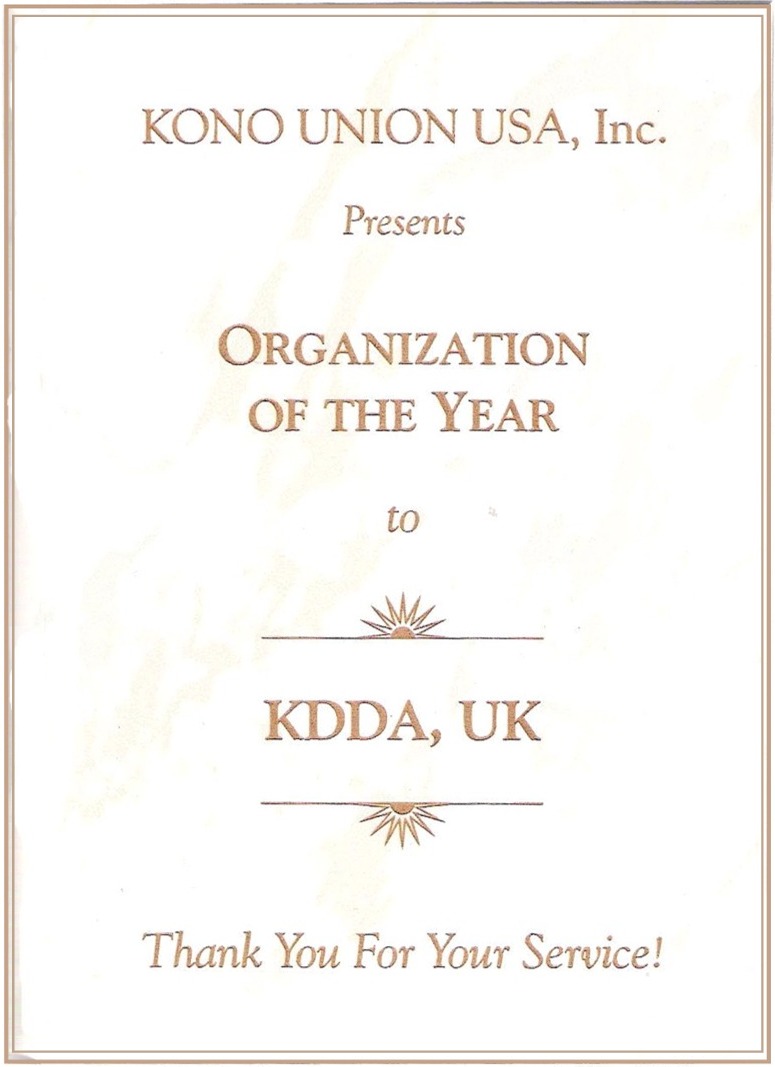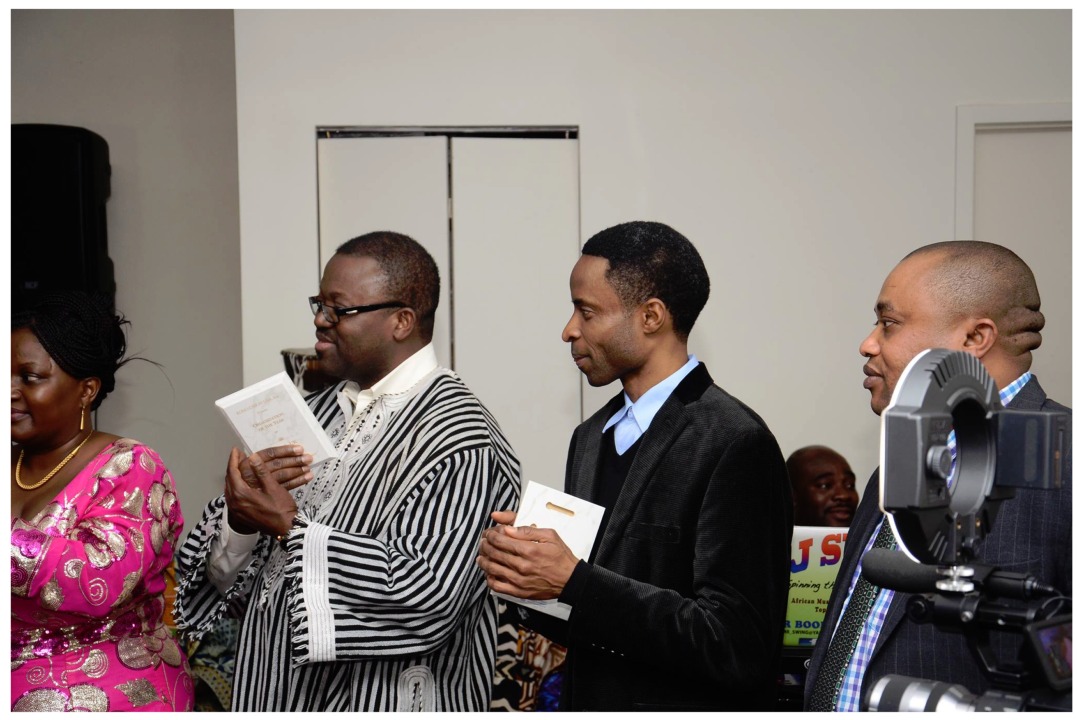|
HOMEAbout UsKono District Chiefdoms
Source: Ministry of Interior Brief Chiefdom HistoryFiama: This chiefdom traces its history to Aiah Kontandey M’briwa, a warrior who established himself in the area. Aiah is likely to have arrived with Kaimachiende M’ba, of Gbense chiefdom. A son of Aiah, Sahr Kontandey M’briwa, was head of the area at first contact with the British and broke off from Gbense to lead in independent chiefdom in 1913. The current chief is Sahr Youngai. He was elected in 2002. The previous chief, Sahr Sanga M’briwa was murdered during the war in 1993. Gbane: This chiefdom traces its origin to two Kono warriors who existed during the 19th century. There is no story of them migrating from anywhere, but the Konos, part of the Mande language group, are thought to have been part of the Mane migration from Mali during the 16th century. Ngobu Kakpata, who settled at Tombodu Mainfe in present day Mongor section. His deputy was Fenfa, who stayed at Kondendu. The first chief of the chiefdom was Ngobu Nyandemoqui, son of Kakpata, who was first to be recognized by the British. The present chief is Aiah Bindi Fenfa Gongor, a Muslim, who was elected in 2010. Sahr Nyandemoqui III, the paramount chief during the war, fled the chiefdom for the duration of the war. Nyandamoqui means “fine leopard”. Gbane Kandor: This chiefdom traces its origin to a warrior named Mamina, who lived during the 19th century. Mamina is said to have been born in Fanda, within the chiefdom, and took the region from other residents in a great battle, causing them to flee to present day Guinea. He hid in the Konogortan hills around the chiefdom and attacked from above. He was succeeded by Kamachi M’bawa, who was recognized as the first paramount chief by the British. The current chief is Sahr Edward M’bawa, a Kono and Muslim. He was elected in 2005. The chiefdom only has one ruling house. Tamba Fia M’bawa was chief during the war, and he fled briefly in 1997. He returned in 2000 and died in 2003. Gbense: This chiefdom surrounds Koidu town, the largest in the diamond mining area of Kono. It traces its origin to a warrior named Kaimachiende M’ba, which means “fearsome” in Kono. During the 19th century informants claim he also held authority over Gbense chiefdom and of the adjacent chiefdom of Fiama. He was arrested by the British during the hut tax rebellion, allowing Tao Kabba to take over. After Tao Kabba was arrested again for financial fraud, Fiama split off from Gbense in 1913, led by Sahr Kontandey M’Briwa, who was perhaps a subordinate to Kaimachiende. Koidu was a site of intense fighting during the RUF rebel war, and the chief during the war was forced to flee in 1998. The chiefdom currently receives revenues from small-scale artisanal diamond mining. The current chief is Sahr Fengai, a Kono elected in 2002, who has his headquarters at Yardu Village. Gorama Kono: Gorama Kono traces its origin to a group of Kono warriors who are thought to have conquered the area during the 19th century. The warriors were led by Konobundor, and included Dugbawa Manyeh, Sogboh, and Kanda. Konobundor was the eldest and became the leader when there was peace. The current chief also has the name Kono Bundor and was elected in 1984. He fled briefly during the war. Kono Bundor - This house traces the history of Bundor, who was the first chief to be recognized by the British. Kamaa: This chiefdom traces its origin to a warrior named Hindowa Ngandi who dislodged the “Kamaranos” from the area. Informants say their local interpretation of Kamara is that it means “someone who does not eat baboon”. The first chief to be recognized by the British was Sumana Tieh, a son of Hindowa. The current chief is Aiah Melvin Ngekiah II, a Muslim Kono elected in 2003. The chief during the war S.G.M. Fania fled in 1992 and died in the United Kingdom in 1999. Tieh - This house traces the lineage of Sumana Tieh the first chief to be recognized by the British. Their headquarters is at Tombodu. Lei: This chiefdom traces its origin to Kogbanda, a Kissi, warrior who migrated from present day Guinea. The story is that there were many chiefs in the area at the time the British arrived. Kogbanda was the only one brave enough to face them, and so was the first to be recognized as chief. His house, the Mani family, has ruled ever since. Sahr Keleti Mani, was elected in 2003. His predecessor, Aiah Alpha Mani, fled the chiefdom in 1992 during the war before dying of natural causes in 2001. The current Paramount chief for Saima's predecessor is Paramount Chief Fengai Mani who survived Paramount Chief A. A. Mani. Mafindor: Mafindor chiefdom borders Guinea along the river Malee. It traces its history to a warrior named Suluku Handupor, a Kono who led the chiefdom throughout the 19th century and was recognized by the British as chief in 1891. In a famous battle, which likely occurred in the 1880s, he deterred the Sofa from the north led by Mori Turay. After the death of chief Sahr Lamin Musa in 1948, this chiefdom was briefly administrated by the chief of Gbane Kandor chiefdom. It became independent again under the leadership of chief Kekura Lyod Musa in 1959. The current chief is Abu M’bawa Kongorba, who was elected in 1986. He played a leadership role in the early part of the war, joining the Kono Council of Paramount Chiefs organized with the consent of the NPRC in 1994. He fled to Guinea during the war between 1997 and 2001. Nimikor: This chiefdom traces its history to a Kono warrior named Foamansa Matturie. He was recognized as first chief by the British in 1876. His descendants, who have formed two families, have alternated rule over the chiefdom. The current chief, Aiah Denton Bona Foamansa III, of the Bona family, was elected in 2006. Matturi - This house traces the lineage of Foamansa Matturie and has its headquarters at Sahr Fillie village. Bona - This house originated from Dudubona, who was related to the Matturi house through marriage, and ruled after Matturi until 1981. They have their headquarters at Bonadae village. Nimiyama: Nimiyama traces its origin to two Kono warriors named Chika and Sogboh Torto, who were recognized as leaders by the British in the late 19th century. The name Nimiyama means “face of the hill” in Kono, and the chiefdom was named this for the hill that faces Sewafe, the town centre. The current chief is a descendant of Torto, George Bockarie Torto, who was elected in 2009. Torto - This house traces the lineage of Sogboh Torto, and is the only family to have ruled the chiefdom. Nyaka - This house traces the lineage of another warrior, Nyaka, who fought with Chika. Their headquarters is at Peya village. They have never assumed the throne. Sandor: This chiefdom traces the lineage of Fasulukuwa, a warrior who is thought to have migrated from Mali. He established himself in the area after successfully defending against the Sofa invasion of the 1880s and was recognized as first chief by the British in 1896. A chiefdom report from 1899 reports that Suluku, at his headquarters in Kayima, was the most powerful chiefdom of the era in Kono district, who once divided the region with Nyagua, another powerful chief at the time. The current chief is Sheku Ahmed Tejan Fasuluku III, a prominent agriculturist who was elected in 2005. The chief during the war, Kaibondo Sunduwa Fasuluku fled. It is suspected that he was viewed as illegitimate and found it difficult to return after the war. The chiefdom during the war was a site of the prominent Donso hunter group, which organized to defend the chiefdom against the RUF. Fasuluku - This house traces the origin of Fasulukuwa. His family has had an abundance of sons and has dominated the chiefdom since the colonial period. Soa: Soa chiefdom traces its origin to a warrior named Gbendawa, who attained prominence defending the area from other groups. He was recognized as the first chief by the British. The current chief is Tamba Emmanuel Toche Foyoh, a Kono who was elected in 2009. Foyoh- This family traces the lineage of Foyohwa, an assistant to Gbendawa who settled at Kainkordu and took the chieftaincy after Gbendawa’s death. Tankor: This chiefdom traces the lineage of a group of Kono warriors who are said to have come from the south and driven the Mandingos from the land in the late 19th century. This chiefdom is undoubtedly quite rich, as it is the headquarters of the Koidu Holdings Kimberlite Project, the largest diamond mine in the country. The chiefdom administration receives surface rents from the project. The current chief is Paul Gaba Saquee, who was elected in 2006. The chief during the war, Joseph Saquee, fled between 1998 and 2002 to escape heavy fighting in the area. Saquee -This house traces the lineage of Pa Sahr Quee, one of the original warriors who fought against the Mandingos. He settled at Baiama. Gando - This house traces the lineage of Pa Tamba Gando, a warrior who fought with Sahr Quee. This family has its headquarters at Yamadu. Gbesseh Gumbu - This house traces the lineage of Pa Gbesseh Gumbu, a messenger to the Quee and Gando houses. He acted as messenger for the Gando and Sahr Quee houses, and during a meeting was given a staff, and thus his family holds the right to rule. Toli: Toli chiefdom traces its origin to Soluku, a warrior who migrated from Guinea. He settled first in Kuateneh in present day Sandor chiefdom, and later moved to Kondewakor, where Soluku’s brother Landa established himself as leader of Toli. Descendants of Soluku have ruled the chiefdom ever since. This chiefdom was at the end of the 19th century considered a part of Neya chiefdom but broke off on its own at the time of Suluku. It is unclear what exact relationship Suluku had with the leaders of Neya at that time. Soluku -This house traces the lineage of Landa, a brother of Soluku. Nya Songoh -This house traces the lineage of Nya Songoh, who lived at the time of Soluku in the late 19th century. They have established their right to stand for election by presenting evidence that Nya Songoh was once arrested with Suluku and thus recognized as chief. Though they were allowed to stand in the 2010 election, there is some controversy about the legitimacy of this family, particularly given the dominance of the Soluku family throughout the chiefdom’s history. |

|















